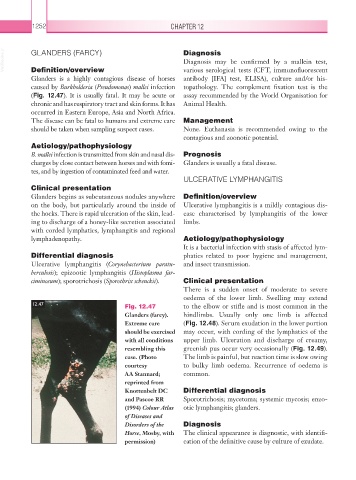Page 1277 - Equine Clinical Medicine, Surgery and Reproduction, 2nd Edition
P. 1277
1252 CHAPTER 12
VetBooks.ir GLANDERS (FARCY) Diagnosis
Diagnosis may be confirmed by a mallein test,
Definition/overview
antibody [IFA] test, ELISA), culture and/or his-
Glanders is a highly contagious disease of horses various serological tests (CFT, immunofluorescent
caused by Burkholderia (Pseudomonas) mallei infection topathology. The complement fixation test is the
(Fig. 12.47). It is usually fatal. It may be acute or assay recommended by the World Organisation for
chronic and has respiratory tract and skin forms. It has Animal Health.
occurred in Eastern Europe, Asia and North Africa.
The disease can be fatal to humans and extreme care Management
should be taken when sampling suspect cases. None. Euthanasia is recommended owing to the
contagious and zoonotic potential.
Aetiology/pathophysiology
B. mallei infection is transmitted from skin and nasal dis- Prognosis
charges by close contact between horses and with fomi- Glanders is usually a fatal disease.
tes, and by ingestion of contaminated feed and water.
ULCERATIVE LYMPHANGITIS
Clinical presentation
Glanders begins as subcutaneous nodules anywhere Definition/overview
on the body, but particularly around the inside of Ulcerative lymphangitis is a mildly contagious dis-
the hocks. There is rapid ulceration of the skin, lead- ease characterised by lymphangitis of the lower
ing to discharge of a honey-like secretion associated limbs.
with corded lymphatics, lymphangitis and regional
lymphadenopathy. Aetiology/pathophysiology
It is a bacterial infection with stasis of affected lym-
Differential diagnosis phatics related to poor hygiene and management,
Ulcerative lymphangitis (Corynebacterium paratu- and insect transmission.
berculosis); epizootic lymphangitis (Histoplasma far-
ciminosum); sporotrichosis (Sporothrix schenckii). Clinical presentation
There is a sudden onset of moderate to severe
oedema of the lower limb. Swelling may extend
12.47 Fig. 12.47 to the elbow or stifle and is most common in the
Glanders (farcy). hindlimbs. Usually only one limb is affected
Extreme care (Fig. 12.48). Serum exudation in the lower portion
should be exercised may occur, with cording of the lymphatics of the
with all conditions upper limb. Ulceration and discharge of creamy,
resembling this greenish pus occur very occasionally (Fig. 12.49).
case. (Photo The limb is painful, but reaction time is slow owing
courtesy to bulky limb oedema. Recurrence of oedema is
AA Stannard; common.
reprinted from
Knottenbelt DC Differential diagnosis
and Pascoe RR Sporotrichosis; mycetoma; systemic mycosis; enzo-
(1994) Colour Atlas otic lymphangitis; glanders.
of Diseases and
Disorders of the Diagnosis
Horse, Mosby, with The clinical appearance is diagnostic, with identifi-
permission) cation of the definitive cause by culture of exudate.

